| ID |
Date |
Author |
Topic |
Subject |
|
2647
|
09 Dec 2023 |
Pavel Murat | Forum | history plotting: where to convert the ADC readings into temps/voltages? | to plot time dependencies of the monitored detector parameters, say, voltages or temperatures,
one needs to convert the coresponging ADC readings into floats.
One could think of two ways of doing that:
- one can perform the ADC-->T or ADC-->V conversion in the MIDAS frontend,
store their [float] values in the data bank, and plot precalculated parameters vs time
- one can also store in the data bank the ADC readings which typically are short's
and convert them into floats (V's or T's) at the plotting time
The first approach doubles the storage space requirements, and I couldn't find the place where
one would do the conversion, if stored were the 16-bit ADC readings.
I'm sure this issue has been thought about, so what is the "recommended MIDAS way" of performing
the ADC -> monitored_number conversion when making MIDAS history plots ?
-- many thanks, regards, Pasha |
|
2650
|
10 Dec 2023 |
Stefan Ritt | Forum | history plotting: where to convert the ADC readings into temps/voltages? | > to plot time dependencies of the monitored detector parameters, say, voltages or temperatures,
> one needs to convert the coresponging ADC readings into floats.
>
> One could think of two ways of doing that:
>
> - one can perform the ADC-->T or ADC-->V conversion in the MIDAS frontend,
> store their [float] values in the data bank, and plot precalculated parameters vs time
>
> - one can also store in the data bank the ADC readings which typically are short's
> and convert them into floats (V's or T's) at the plotting time
>
> The first approach doubles the storage space requirements, and I couldn't find the place where
> one would do the conversion, if stored were the 16-bit ADC readings.
>
> I'm sure this issue has been thought about, so what is the "recommended MIDAS way" of performing
> the ADC -> monitored_number conversion when making MIDAS history plots ?
Most experiment go with the second method. The front-end program converts all ADC reading into physicsl
units, i.e. not only Volt, but even Degrees Centigrade or Tesla or whatever. The slow control part of
midas then puts these number into /Equipment/<name>/Variables as "float", and the history system picks
them up from there. This way your history is shown in physical units and not ADC count. Actually the
recommended slow control framework (check the examples direcotory) does not rely on data banks, but
puts values directly into the ODB. This is typically done faster, like once per second if a value
changes, rather than slow control events which are generated maybe once per 10 seconds or once per
minute. Usually the slow control values are only few compared with trigger data, so a factor of two
there does not really matter. In the MEG experiment, we have like 400 GB of slow control data per year,
but 400 TB of trigger data per year.
Best,
Stefan |
|
2652
|
11 Dec 2023 |
Pavel Murat | Forum | the logic of handling history variables ? | Dear MIDAS developers,
I'm trying to understand handling of the history (slow control) variables in MIDAS,
and it seems that the behavior I'm observing is somewhat counterintuitive.
Most likely, I just do not understand the implemented logic.
As it it rather difficult to report on the behavior of the interactive program,
I'll describe what I'm doing and illustrate the report with the series of attached
screenshots showing the history plots and the status of the run control at different
consecutive points in time.
Starting with the landscape:
- I'm running MIDAS, git commit=30a03c4c (the latest, as of today).
- I have built the midas/examples/slowcont frontend with the following modifications.
(the diffs are enclosed below):
1) the frequency of the history updates is increased from 60sec/10sec to 6sec/1sec
and, in hope to have updates continuos, I replaced (RO_RUNNING | RO_TRANSITIONS)
with RO_ALWAYS.
2) for convenience of debugging, midas/drivers/nulldrv.cxx is replaced with its clone,
which instead of returning zeroes in each channel, generates a sine curve:
V(t) = 100*sin(t/60)+10*channel
- an active channel in /Logger/History is chosen to be FILE
- /History/LoggerHistoryChannel is also set to FILE
- I'm running mlogger and modified, as described, 'scfe' frontend from midas/examples/slowcont
- the attached history plots include three (0,4 and 7) HV:MEASURED channels
Now, the observations:
1) the history plots are updated only when a new run starts, no matter how hard
I'm trying to update them by clicking on various buttons.
The attached screenshots show the timing sequence of the run control states
(with the times printed) and the corresponding history plots.
The "measured voltages" change only when the next run starts - the voltage graphs
break only at the times corresponding to the vertical green lines.
2) No matter for how long I wait within the run, the history updates are not happening.
3) if the time difference between the two run starts gets too large,
the plotted time dependence starts getting discontinuities
4) finally, if I switch the logging channel from FILE to MIDAS (activate the MIDAS
channel in /Logger/History and set /History/LoggerHistoryChannel to MIDAS),
the updates of the history plots simply stop.
MIDAS feels as a great DAQ framework, so I would appreciate any suggestion on
what I could be doing wrong. I'd also be happy to give a demo in real time
(via ZOOM/SKYPE etc).
-- much appreciate your time, thanks, regards, Pasha
------------------------------------------------------------------------------
diff --git a/examples/slowcont/scfe.cxx b/examples/slowcont/scfe.cxx
index 11f09042..c98d37e8 100644
--- a/examples/slowcont/scfe.cxx
+++ b/examples/slowcont/scfe.cxx
@@ -24,9 +24,10 @@
#include "mfe.h"
#include "class/hv.h"
#include "class/multi.h"
-#include "device/nulldev.h"
#include "bus/null.h"
+#include "nulldev.h"
+
/*-- Globals -------------------------------------------------------*/
/* The frontend name (client name) as seen by other MIDAS clients */
@@ -74,11 +75,11 @@ EQUIPMENT equipment[] = {
0, /* event source */
"FIXED", /* format */
TRUE, /* enabled */
- RO_RUNNING | RO_TRANSITIONS, /* read when running and on transitions */
- 60000, /* read every 60 sec */
+ RO_ALWAYS, /* read when running and on transitions */
+ 6000, /* read every 6 sec */
0, /* stop run after this event limit */
0, /* number of sub events */
- 10000, /* log history at most every ten seconds */
+ 1000, /* log history at most every one second */
"", "", ""} ,
cd_hv_read, /* readout routine */
cd_hv, /* class driver main routine */
@@ -93,8 +94,8 @@ EQUIPMENT equipment[] = {
0, /* event source */
"FIXED", /* format */
TRUE, /* enabled */
- RO_RUNNING | RO_TRANSITIONS, /* read when running and on transitions */
- 60000, /* read every 60 sec */
+ RO_ALWAYS, /* read when running and on transitions */
+ 6000, /* read every 6 sec */
0, /* stop run after this event limit */
0, /* number of sub events */
1, /* log history every event as often as it changes (max 1 Hz) */
------------------------------------------------------------------------------
[test_001]$ diff ../midas/examples/slowcont/nulldev.cxx ../midas/drivers/device/nulldev.cxx
13d12
< #include <math.h>
150,154c149,150
< if (channel < info->num_channels) {
< // *pvalue = info->array[channel];
< time_t t = time(NULL);;
< *pvalue = 100*sin(M_PI*t/60)+10*channel;
< }
---
> if (channel < info->num_channels)
> *pvalue = info->array[channel];
------------------------------------------------------------------------------ |
| Attachment 1: Screenshot_20231211_213608.png
|
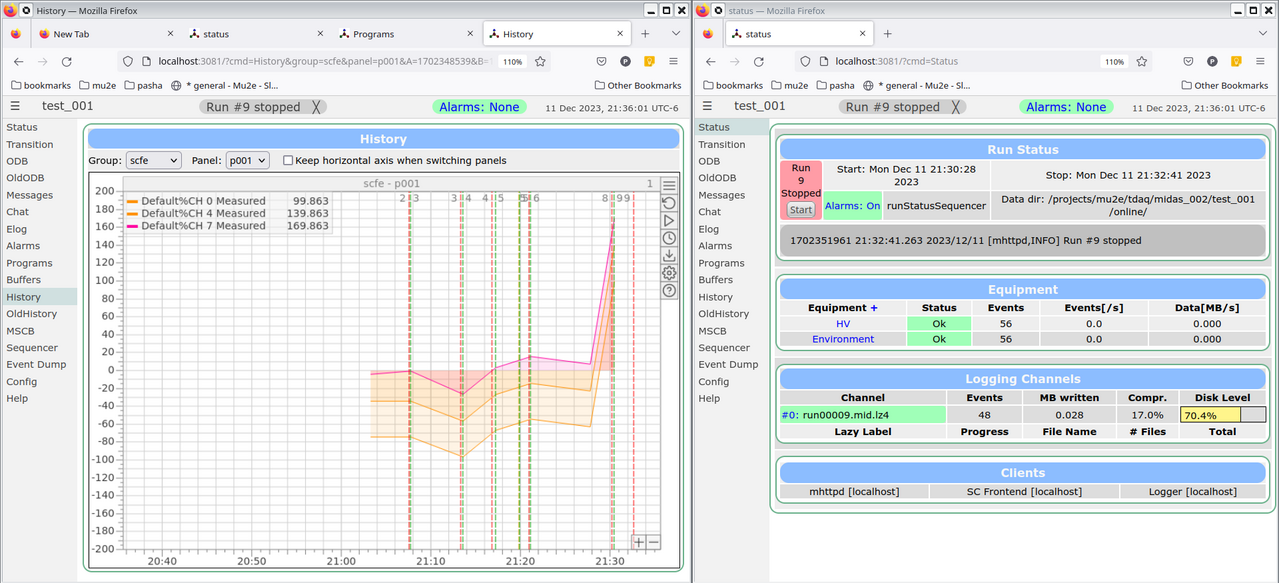
|
| Attachment 2: Screenshot_20231211_213736.png
|

|
| Attachment 3: Screenshot_20231211_220347.png
|
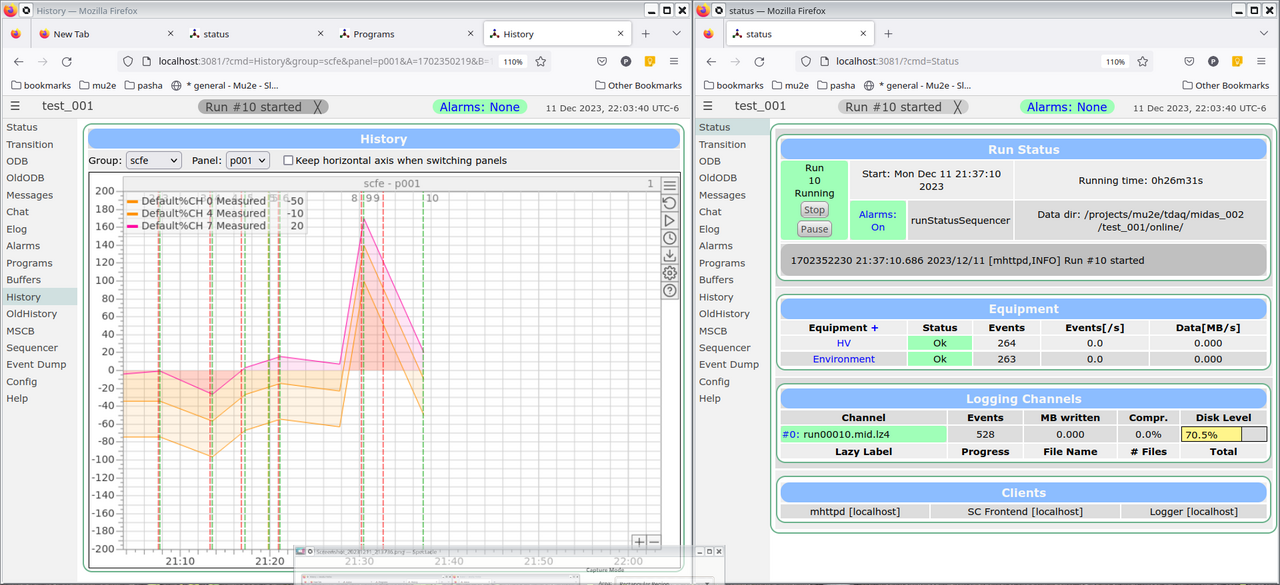
|
| Attachment 4: Screenshot_20231211_220508.png
|
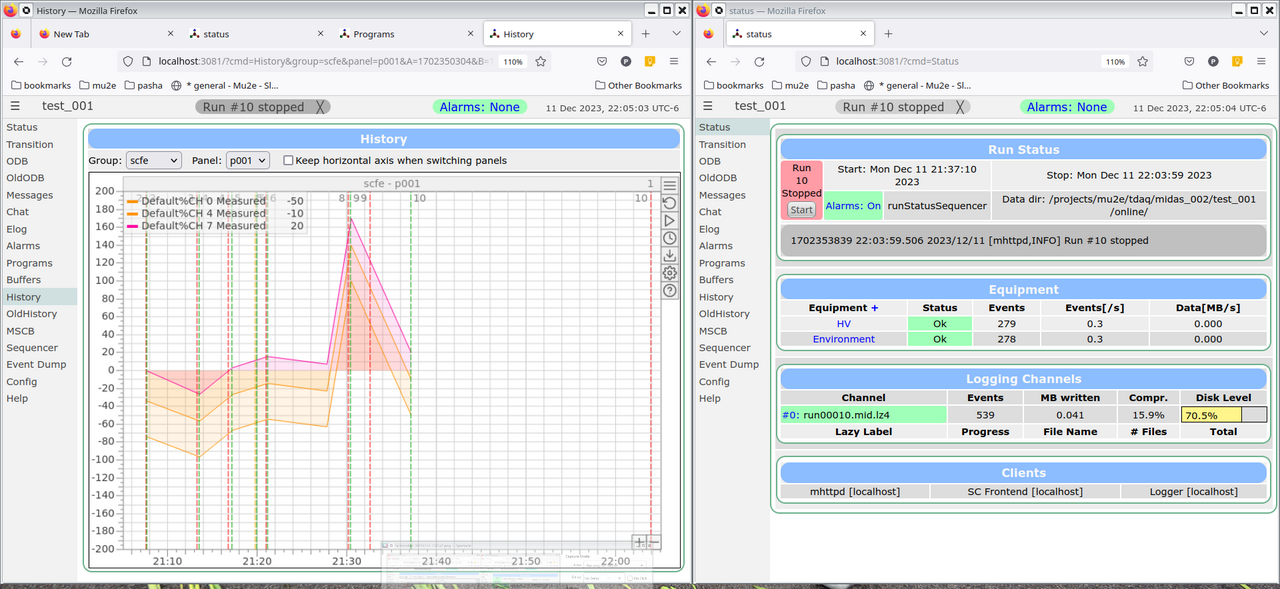
|
| Attachment 5: Screenshot_20231211_221041.png
|
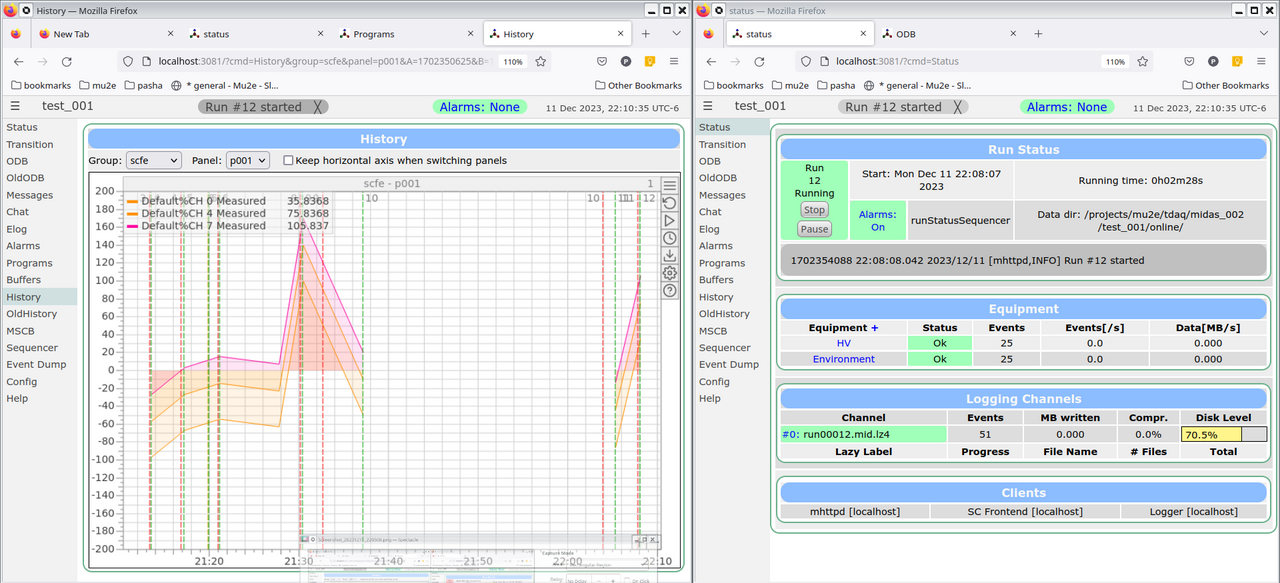
|
| Attachment 6: Screenshot_20231211_221252.png
|
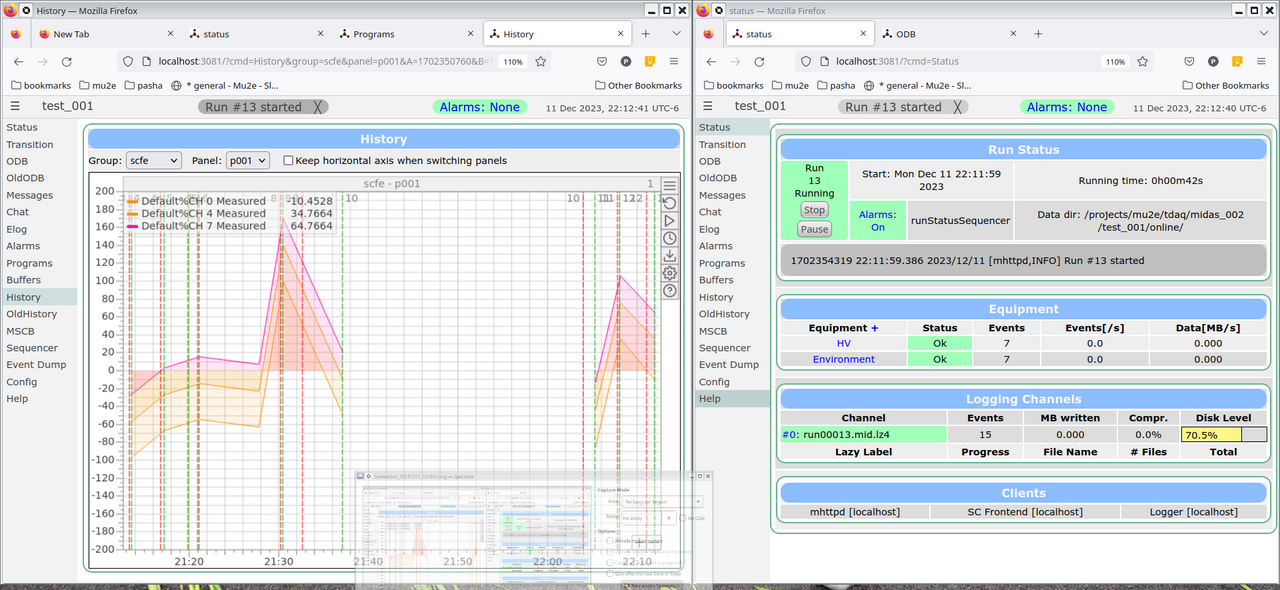
|
| Attachment 7: Screenshot_20231211_221406.png
|
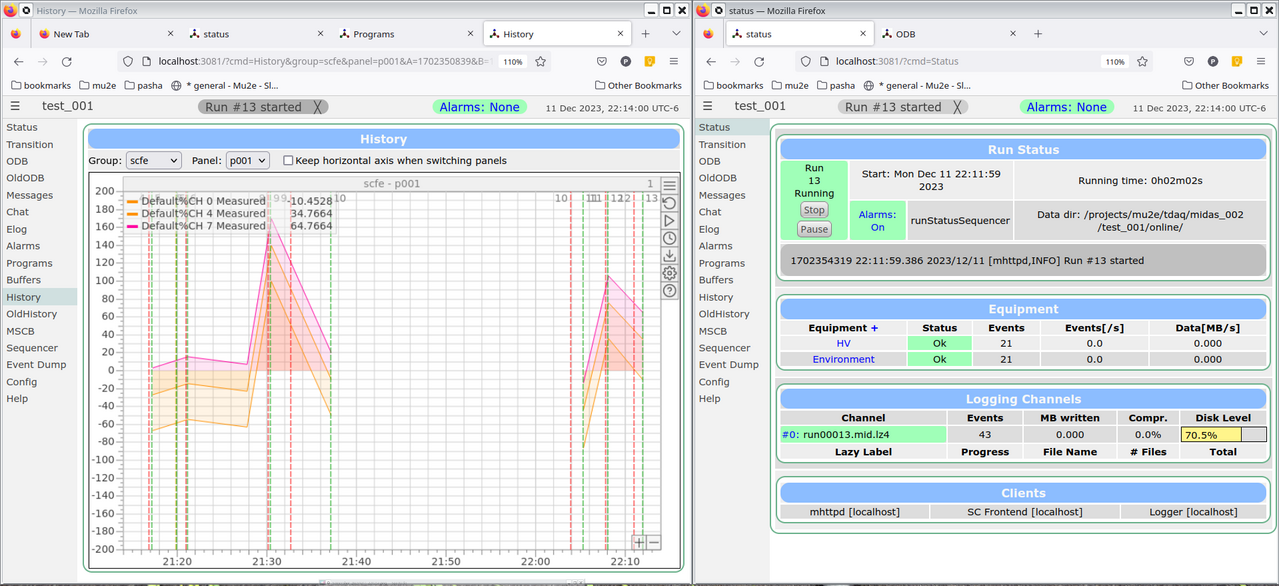
|
| Attachment 8: Screenshot_20231211_222042.png
|

|
| Attachment 9: Screenshot_20231211_222114.png
|

|
| Attachment 10: Screenshot_20231211_224016.png
|
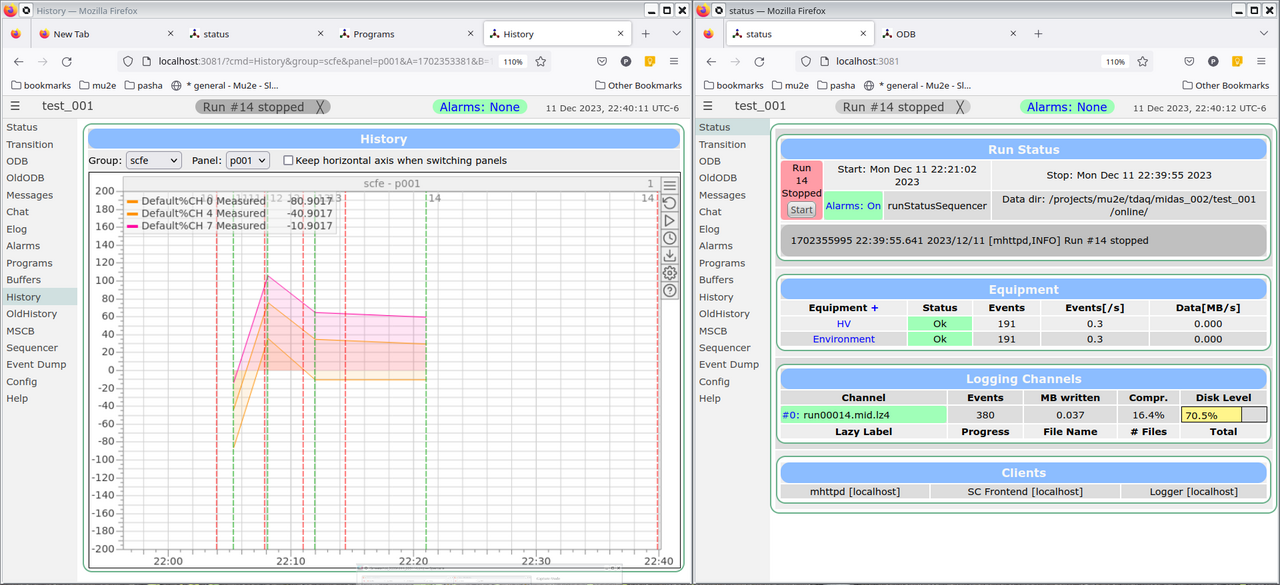
|
| Attachment 11: Screenshot_20231211_224141.png
|
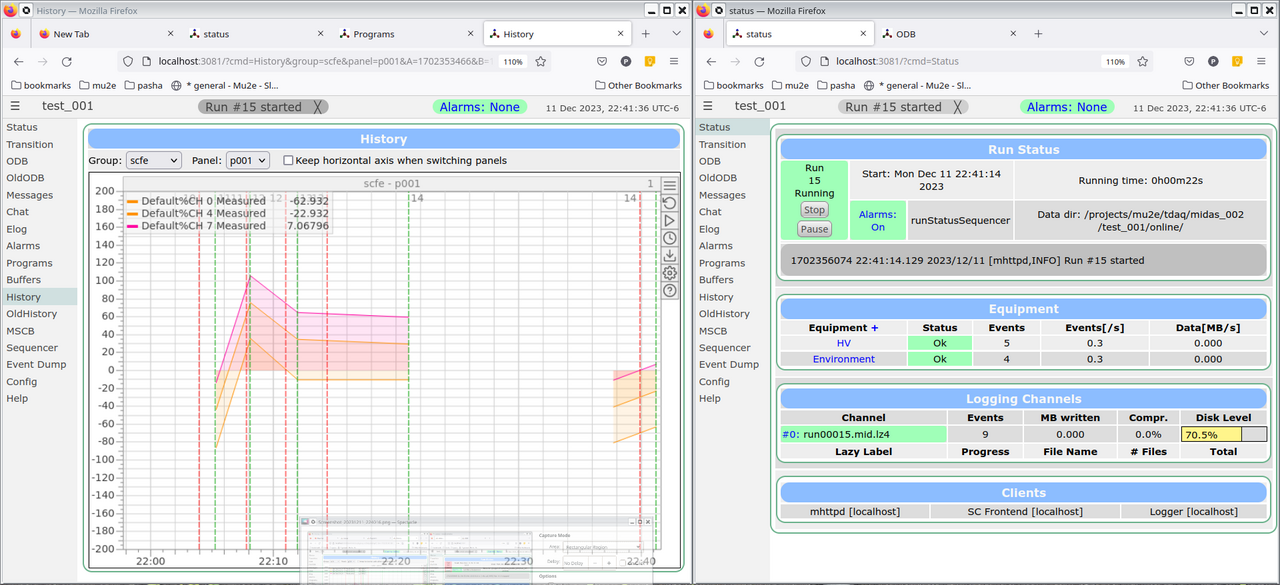
|
|
2653
|
11 Dec 2023 |
Stefan Ritt | Forum | the logic of handling history variables ? | First of all it's important to understand that the slow control system has nothing to do
with events. So if you look at event statistics, these are the events with the slow control
data sent to the midas data file, not the history database. So the logging period (the one you
decreased from 60s to 10s to 6s) only affect the generation of events.
What is important in your case is the number of events sent to the ODB. You see these in the
screen output of the slow control frontend (see attachment). This number show increase every
second.
I tried your modification (change nulldev with a sine function), and left the sc_fe.cxx
otherwise untouched. I then started with a fresh ODB ("rm /"). Started logger, mhttpd, sc_fe
and started a run. In the attachments is what I see. So I don't understand what your problem
is. |
| Attachment 1: Screenshot_2023-12-12_at_09.03.13.png
|

|
| Attachment 2: Screenshot_2023-12-12_at_08.57.45.png
|
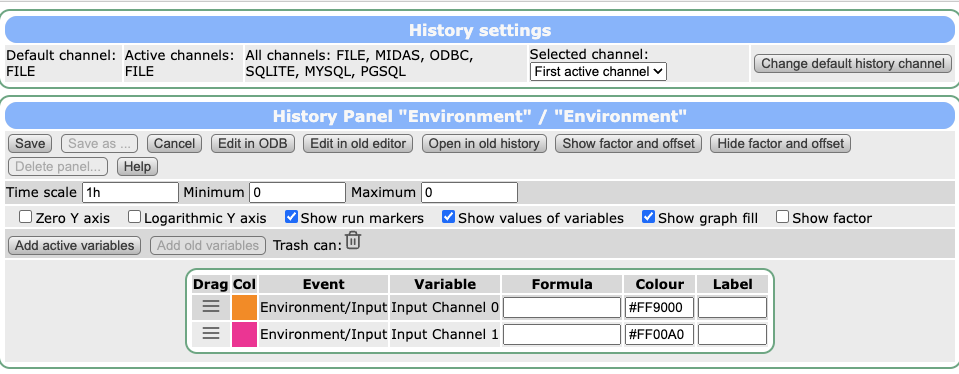
|
| Attachment 3: Screenshot_2023-12-12_at_08.55.14.png
|
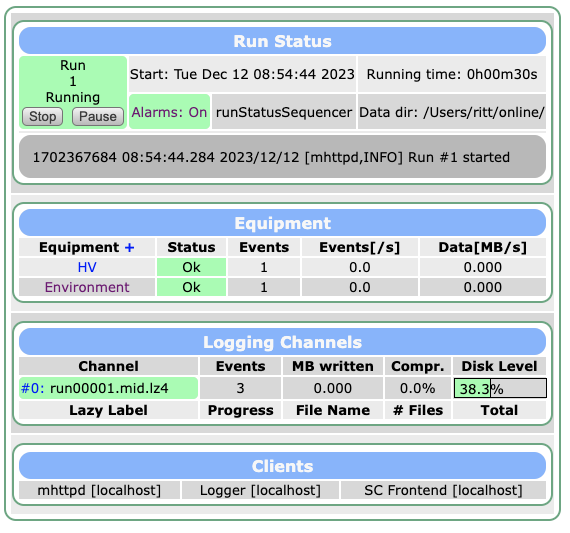
|
| Attachment 4: Screenshot_2023-12-12_at_08.57.37.png
|
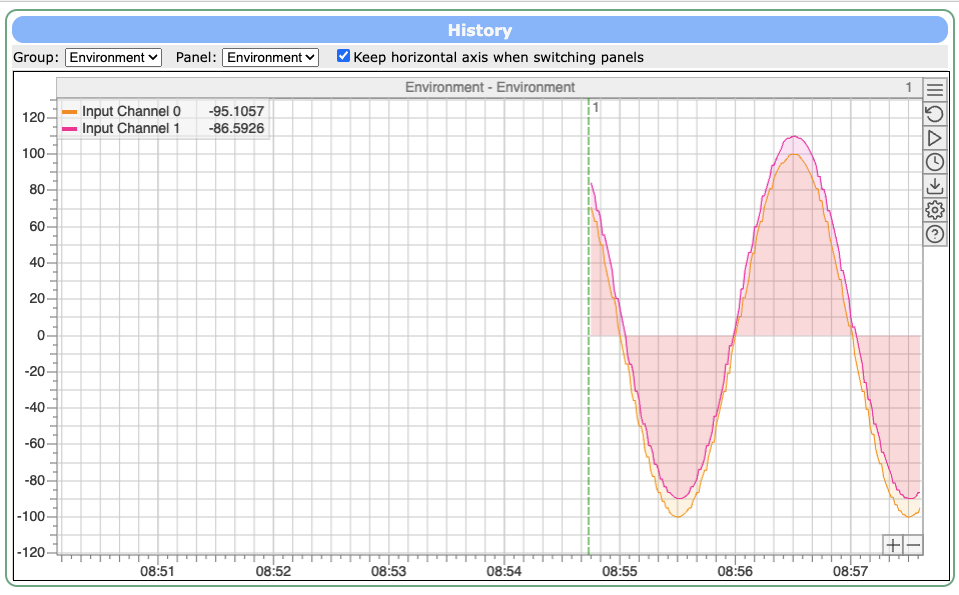
|
|
2656
|
12 Dec 2023 |
Pavel Murat | Forum | the logic of handling history variables ? | Hi Sfefan, thanks a lot for taking time to reproduce the issue!
Here comes the resolution, and of course, it was something deeply trivial :
the definition of the HV equipment in midas/examples/slowcont/scfe.cxx has
the history logging time in seconds, however the comment suggests milliseconds (see below),
and for a few days I believed to the comment (:smile:)
Easy to fix.
Also, I think that having a sine wave displayed by midas/examples/slowcont/scfe.cxx
would make this example even more helpful.
-- thanks again, regards, Pasha
--------------------------------------------------------------------------------------------------------
EQUIPMENT equipment[] = {
{"HV", /* equipment name */
{3, 0, /* event ID, trigger mask */
"SYSTEM", /* event buffer */
EQ_SLOW, /* equipment type */
0, /* event source */
"FIXED", /* format */
TRUE, /* enabled */
RO_RUNNING | RO_TRANSITIONS, /* read when running and on transitions */
60000, /* read every 60 sec */
0, /* stop run after this event limit */
0, /* number of sub events */
10000, /* log history at most every ten seconds */ // <------------ this is 10^4 seconds, not 10 seconds
"", "", ""} ,
cd_hv_read, /* readout routine */
cd_hv, /* class driver main routine */
hv_driver, /* device driver list */
NULL, /* init string */
},
https://bitbucket.org/tmidas/midas/src/7f0147eb7bc7395f262b3ae90dd0d2af0625af39/examples/slowcont/scfe.cxx#lines-81 |
|
2657
|
13 Dec 2023 |
Stefan Ritt | Forum | the logic of handling history variables ? | > Also, I think that having a sine wave displayed by midas/examples/slowcont/scfe.cxx
> would make this example even more helpful.
Indeed. I reworked the example to have a out-of-the-box sine wave plotter, including the
automatic creation of a history panel. Thanks for the hint.
Best,
Stefan |
|
2661
|
27 Dec 2023 |
Konstantin Olchanski | Forum | MidasWiki updated to 1.39.6 | MidasWiki was updated to current mediawiki LTS 1.39.6 supported until Nov 2025,
see https://www.mediawiki.org/wiki/Version_lifecycle
as downside, after this update, I see large amounts of "account request" spam,
something that did not exist before. I suspect new mediawiki phones home to
subscribe itself to some "please spam me" list.
if you want a user account on MidasWiki, please email me or Stefan directly, we
will make it happen.
K.O. |
|
2663
|
02 Jan 2024 |
Konstantin Olchanski | Forum | midas.triumf.ca alias moved to daq00.triumf.ca | the DNS alias for midas.triumf.ca moved from old ladd00.triumf.ca to new
daq00.triumf.ca. same as before it redirects to the MidasWiki and to the midas
forum (elog) that moved from ladd00 to daq00 quite some time ago. if you see any
anomalies in accessing them (broken links, bad https certificates), please report
them to this forum or to me directly at olchansk@triumf.ca. K.O. |
|
2664
|
03 Jan 2024 |
Stefan Ritt | Forum | midas.triumf.ca alias moved to daq00.triumf.ca | > the DNS alias for midas.triumf.ca moved from old ladd00.triumf.ca to new
> daq00.triumf.ca. same as before it redirects to the MidasWiki and to the midas
> forum (elog) that moved from ladd00 to daq00 quite some time ago. if you see any
> anomalies in accessing them (broken links, bad https certificates), please report
> them to this forum or to me directly at olchansk@triumf.ca. K.O.
I found the first issue: The link to
https://midas.triumf.ca/MidasWiki/index.php/Custom_plots_with_mplot
does not work any more. The link
https://daq00.triumf.ca/MidasWiki/index.php/Custom_plots_with_mplot
however does work. Same with
https://midas.triumf.ca/MidasWiki/index.php/Sequencer
and
https://daq00.triumf.ca/MidasWiki/index.php/Sequencer
I have a few cases in mhttpd where I link directly to our documentation. I prefer
to have those link with "midas.triumf.ca" instead of "daq00.triumf.ca" in case you
change the machine again in the future.
Best,
Stefan |
|
2666
|
03 Jan 2024 |
Konstantin Olchanski | Forum | midas.triumf.ca alias moved to daq00.triumf.ca | > I found the first issue: The link to
> https://midas.triumf.ca/MidasWiki/index.php/Custom_plots_with_mplot
fixed.
https://midas.triumf.ca/Custom_plots_with_mplot
also works.
I tried to get rid of redirect to daq00 completely and make the whole MidasWiki show up
under midas.triumf.ca, but discovered/remembered that I cannot do this without changing
MidasWiki config [$wgServer = "https://daq00.triumf.ca";] which causes mediawiki to
redirect everything to daq00 (using the 301 "moved permanently" reply, ouch!). In theory,
if I change it to "https://midas.triumf.ca" it will redirect everything there instead,
but I am hesitant to make this change. It has been like this since forever and I have no
idea what else will break if I change it.
K.O. |
|
2667
|
10 Jan 2024 |
Pavel Murat | Forum | slow control frontends - how much do they sleep and how often their drivers are called? | Dear all,
I have implemented a number of slow control frontends which are directed to update the
history once in every 10 sec, and they do just that.
I expected that such frontends would be spending most of the time sleeping and waking up
once in ten seconds to call their respective drivers and send the data to the server.
However I observe that each frontend process consumes almost 100% of a single core CPU time
and the frontend driver is called many times per second.
Is that the expected behavior ?
So far, I couldn't find the place in the system part of the frontend code (is that the right
place to look for?) which regulates the frequency of the frontend driver calls, so I'd greatly
appreciate if someone could point me to that place.
I'm using the following commit:
commit 30a03c4c develop origin/develop Make sure line numbers and sequence lines are aligned.
-- many thanks, regards, Pasha |
|
2668
|
11 Jan 2024 |
Stefan Ritt | Forum | slow control frontends - how much do they sleep and how often their drivers are called? | Put a
ss_sleep(10);
into your frontend_loop(), then you should be fine.
The event loop runs as fast as possible in order not to miss any (triggered) event, so no seep in the
event loop, because this would limit the (triggered) event rate to 100 Hz (minimum sleep is 10 ms).
Therefore, you have to slow down the event loop manually with the method described above.
Best,
Stefan |
|
2669
|
11 Jan 2024 |
Pavel Murat | Forum | slow control frontends - how much do they sleep and how often their drivers are called? | Hi Stefan, thanks a lot !
I just thought that for the EQ_SLOW type equipment calls to sleep() could be hidden in mfe.cxx
and handled based on the requested frequency of the history updates.
Doing the same in the user side is straighforward - the important part is to know where the
responsibility line goes (: smile :)
-- regards, Pasha |
|
2670
|
12 Jan 2024 |
Stefan Ritt | Forum | slow control frontends - how much do they sleep and how often their drivers are called? | > Hi Stefan, thanks a lot !
>
> I just thought that for the EQ_SLOW type equipment calls to sleep() could be hidden in mfe.cxx
> and handled based on the requested frequency of the history updates.
Most people combine EQ_SLOW with EQ_POLLED, so they want to read out as quickly as possible. Since
the framework cannot "guess" what the users want there, I removed all sleep() in the framework.
> Doing the same in the user side is straighforward - the important part is to know where the
> responsibility line goes (: smile :)
Pushing this to the user gives you more freedom. Like you can add sleep() for some frontends, but not
for others, only when the run is stopped and more.
Stefan |
|
2671
|
15 Jan 2024 |
Frederik Wauters | Forum | dump history FILE files | We switched from the history files from MIDAS to FILE, so we have *.dat files now (per variable), instead of the old *.hst.
How shoul
d one now extract data from these data files? With the old *,hst files I can e.g. mhdump -E 102 231010.hst
but with the new *.dat files I get
...2023/history$ mhdump -E 0 -T "Run number" mhf_1697445335_20231016_run_transitions.dat | head -n 15
event name: [Run transitions], time [1697445335]
tag: tag: /DWORD 1 4 /timestamp
tag: tag: UINT32 1 4 State
tag: tag: UINT32 1 4 Run number
record size: 12, data offset: 1024
record 0, time 1697557722, incr 112387
record 1, time 1697557783, incr 61
record 2, time 1697557804, incr 21
record 3, time 1697557834, incr 30
record 4, time 1697557888, incr 54
record 5, time 1697558318, incr 430
record 6, time 1697558323, incr 5
record 7, time 1697558659, incr 336
record 8, time 1697558668, incr 9
record 9, time 1697558753, incr 85
not very intelligible
Yes, I can do csv export on the webpage. But it would be nice to be able to extract from just the files. Also, the webpage export only saves the data shown ( range limited and/or downsampled) |
|
2672
|
16 Jan 2024 |
Pavel Murat | Forum | a scroll option for "add history variables" window? | Dear all,
I have a "slow control" frontend which reads out 100 slow control parameters.
When I'm interactively adding a parameter to a history plot,
a nice "Add history variable" pops up .. , but with 100 parameters in the list,
it doesn't fit within the screen...
The browser becomes passive, and I didn't find any easy way of scrolling.
In the attached example, adding a channel 32 variable becomes rather cumbersome,
not speaking about channel 99.
Two questions:
a) how do people get around this "no-scrolling" issue? - perhaps there is a workaround
b) how big of a deal is it to add a scroll bar to the "Add history variables" popup ?
- I do not know javascript myself, but could find help to contribute..
-- many thanks, regards, Pasha |
| Attachment 1: adding_a_variable_to_the_history_plot.png
|
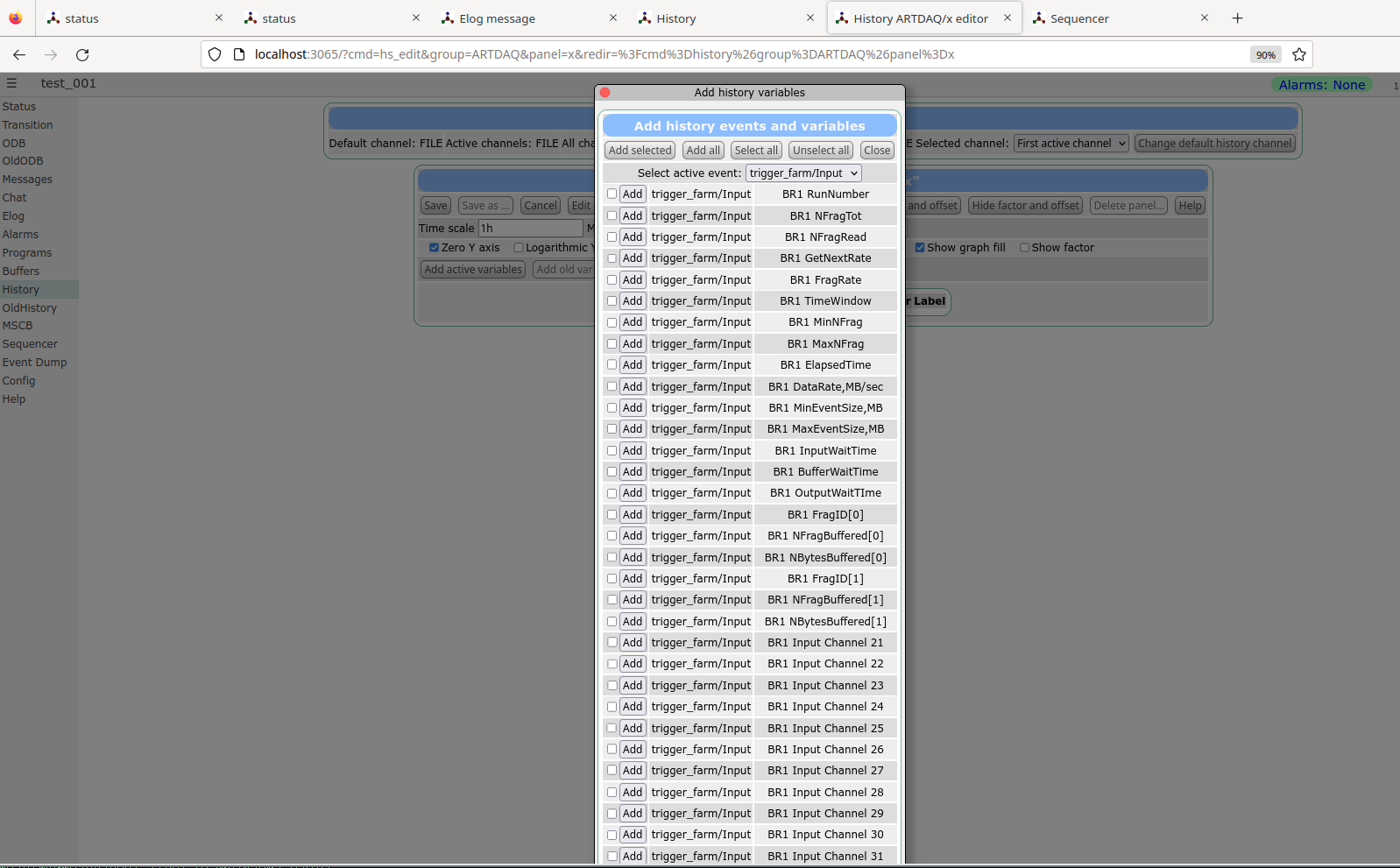
|
|
2673
|
16 Jan 2024 |
Stefan Ritt | Forum | a scroll option for "add history variables" window? | Have you updated to the current midas version? This issue has been fixed a while ago. Below
you see a screenshot of a long list scrolled all the way to the bottom.
Revision: Thu Dec 7 14:26:37 2023 +0100 - midas-2022-05-c-762-g1eb9f627-dirty on branch
develop
Chrome on MacOSX 14.2.1
The fix is actually in "controls.js", so make sure your browser does not cache an old
version of that file. I usually have to clear my browser history to get the new file from
mhttpd.
Best regards,
Stefan |
| Attachment 1: Screenshot_2024-01-17_at_08.17.30.png
|
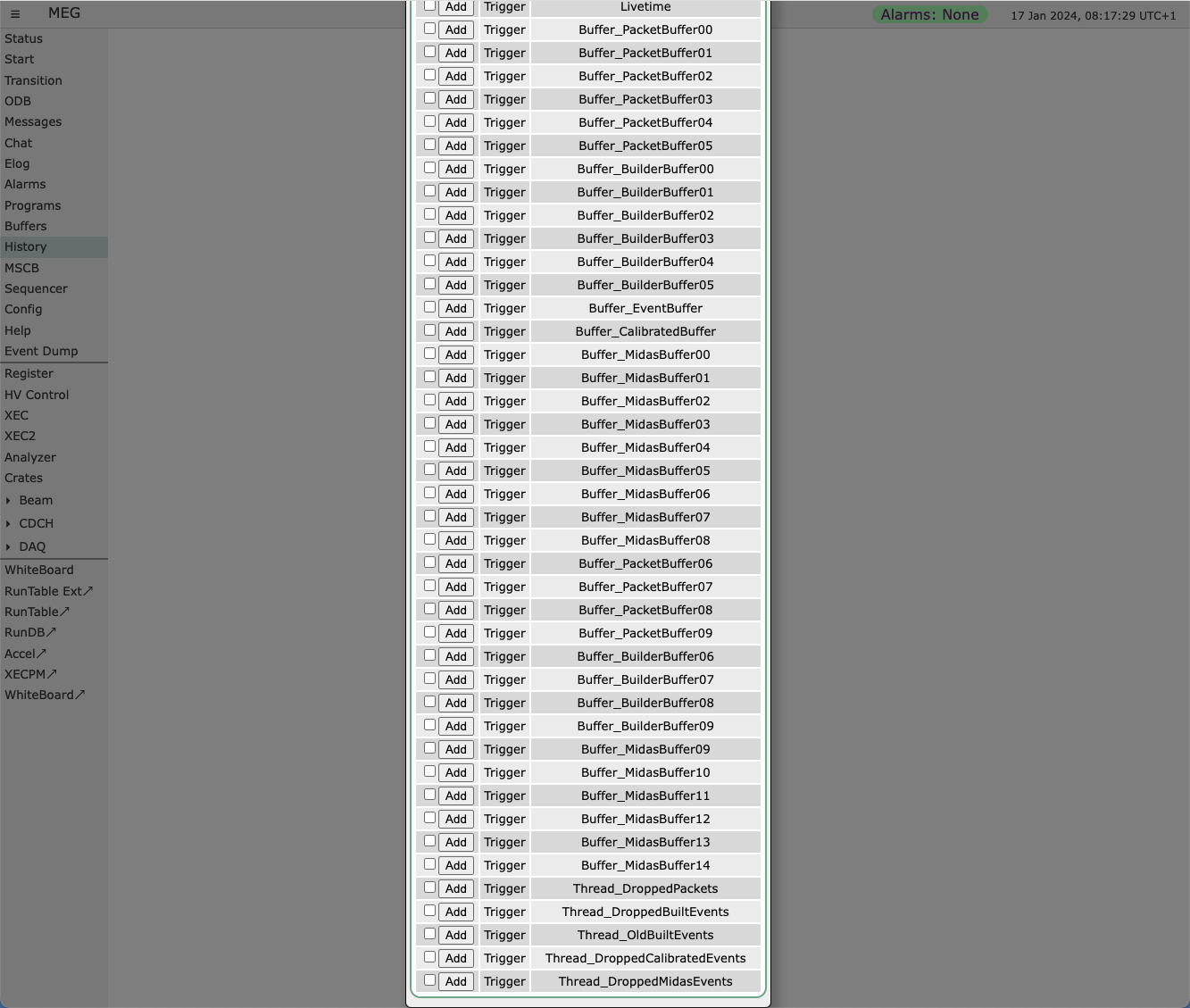
|
|
2676
|
17 Jan 2024 |
Francesco Renga | Forum | History tags | Dear experts,
I would like to have some clarification about the meaning and use of the
tags in the ODB under /History/Tags.
I noticed that, if a history plot is created, but the name of the corresponding
variable is changed later and the plot is modified accordingly, the old name
persists in the /History/Tags list along with the new one. So, it appears in the
list of variables when a new history plot is created.
It seems not to compromise the functionalities of the history system, but it is
prone to create confusion.
Is it the expected behavior? What is the correct procedure to follow if the name
of a variable has to be changed?
Thank you,
Francesco |
|
2677
|
17 Jan 2024 |
Pavel Murat | Forum | a scroll option for "add history variables" window? | > Have you updated to the current midas version? This issue has been fixed a while ago.
Hi Stefan, thanks a lot! I pulled from the head, and the scrolling works now. -- regards, Pasha |
|
2679
|
18 Jan 2024 |
Andreas Suter | Forum | mhttpd eqtable | I have two more questions related to Units, Format for Equipment/Settings:
1) It looks as if I can have units per channel only for the Input/Output channels but not for Demand/Measured channels.
For instance we do have HV FE which collect devices with kV and V demand settings. It looks like this is not possible (see attachment) to have per channel units.
Is this right, or do I miss something here?
2) This new functionality needs entries under /Equipment/<eq-name>/Settings. The class driver generates the necessary structures if they are missing at the startup
of the scfe. It would be nice that the new, additional entries would be generate as well: Editable, Unit Input, Unit Format, etc. Perhaps optionally, if a DD is providing it?
Best,
Andreas |
| Attachment 1: hv-web.png
|

|
|